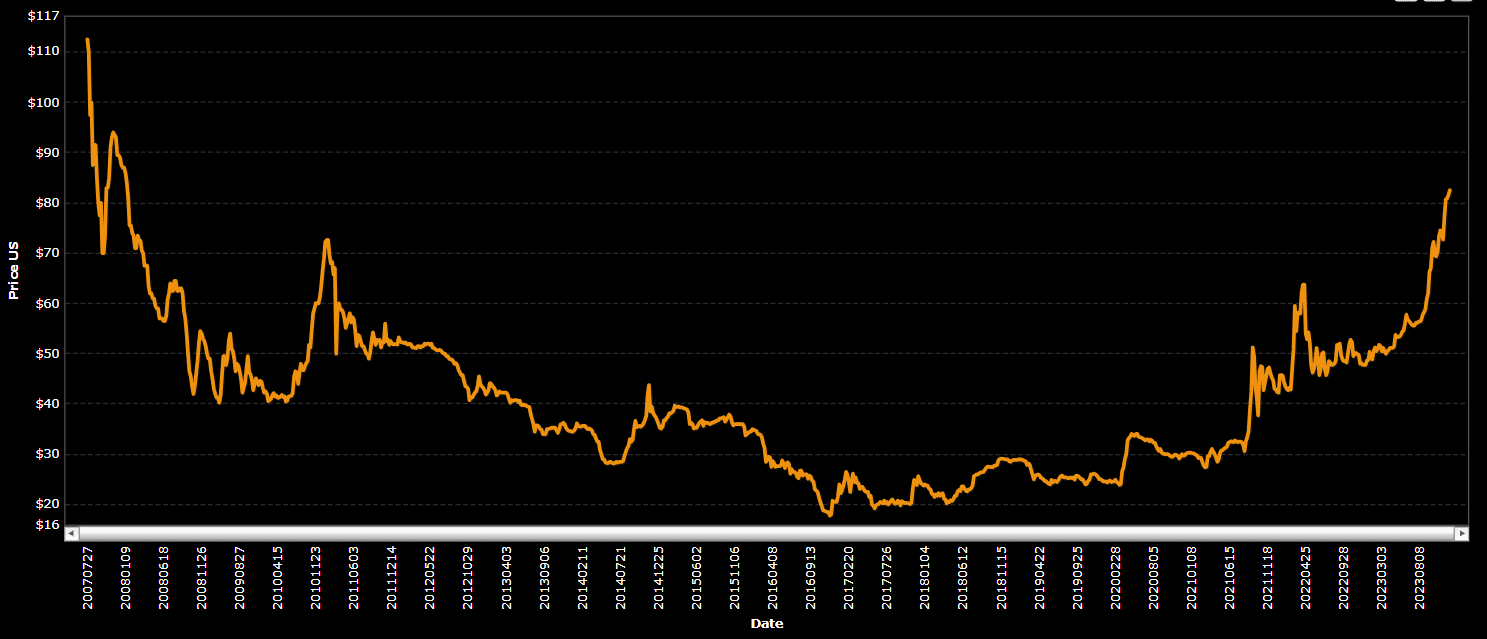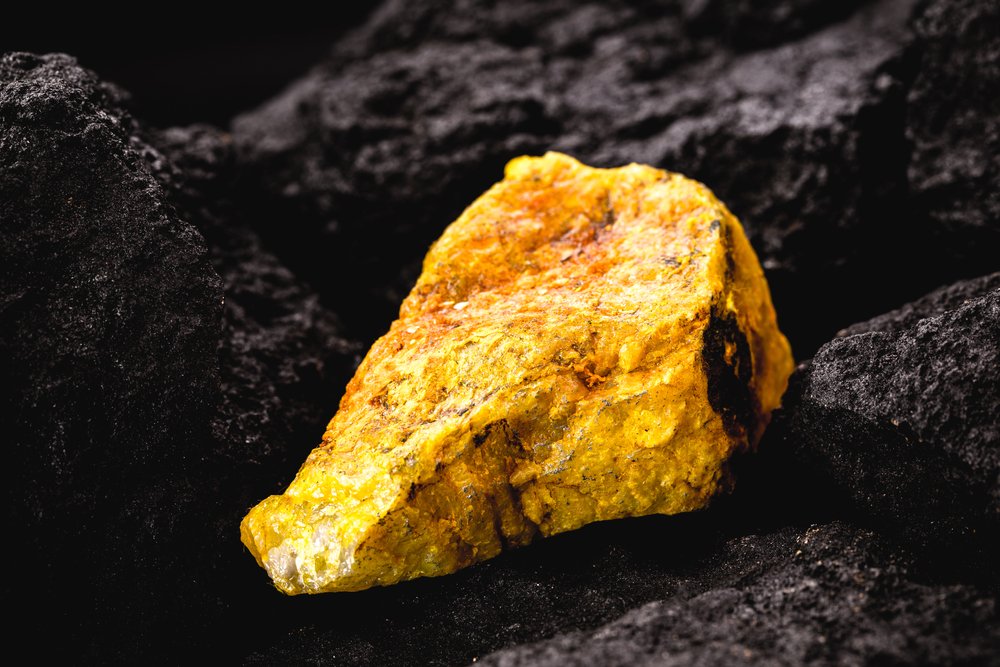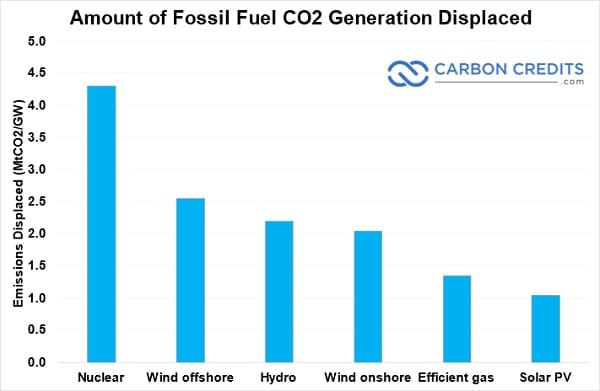Uranium prices are a significant topic for investors, policymakers, and energy enthusiasts given its role in the global energy landscape. The uranium spot price is at 15-year high due to strong market demand and bullish long term outlook, confirming analysts’ forecast of a major sector rally.
As technology progresses, the demand for effective energy sources grows. Uranium holds a key position in generating nuclear power, making it a standout energy resource.
- Relevant: Live Uranium Price Today
The Powerhouse Driving Nuclear Energy Revolution
Uranium Spot Price USD/Pound

The 15-year high uranium price at $85 per pound, the highest since January 2008, is influenced by several factors.
Basically, supply and demand dynamics do impact uranium prices. Rising nuclear power adoption also drives demand up while mining challenges and political tensions affect the supply side.
From 2019 onwards, the uranium market experienced a shortage in supply, depleting the surpluses accumulated since the Fukushima incident in 2011. This scarcity drove prices upward owing to limited availability.
Amid the soaring prices, mining uranium is costly; production expenses directly impact prices. Higher production costs set a price floor as miners avoid selling below production expenses.
National and global regulations also affect uranium markets. Stringent safety and environmental standards raise production costs, while policies supporting clean energy can stimulate demand.
The strong demand for uranium is further driven by its role in achieving net zero emissions and geopolitical risks. This prompted utilities to buy more than 150 million pounds of uranium in 2023, a record high since 2012.
It’s worthy to highlight that uranium prices aren’t just a number; it reflects the shifting global energy landscape. In addressing climate change and ensuring energy security, uranium continues to hold a critical role in the global energy mix.
- Currently, there are 440 nuclear power plants across 33 countries, jointly contributing 10% of the world’s electricity supply. Moreover, plans are in place for an additional 90 nuclear reactors, while proposals exist for over 300 more.
The International Energy Agency stresses the necessity of doubling the size of the nuclear industry within the next two decades to meet net zero targets.
Right now, around 400 nuclear reactors are operational worldwide, highlighting the anticipated growth and importance of nuclear energy in the future energy landscape.
Decarbonizing the Global Energy Matrix
At the recently concluded COP28, a pivotal decision emerged: to triple nuclear energy capacity by 2050. It marks a substantial victory against emissions, which is not surprising.
Nuclear energy offers a high-output, low-carbon alternative to fossil fuels, a crucial step in reducing global warming.
A significant commitment has been made by the COP28 climate negotiators to boost nuclear energy by mid-century, aiding global decarbonization. The United States also joined the effort, signaling increased backing and potential funding for nuclear projects worldwide.
In addition to growing demand, there is also an influx of investment into the sector. Key players like Google and BNB Paribas are betting on nuclear, presenting a broader investment landscape in nuclear energy.
Finally, the International Atomic Energy Agency (IAEA) also fully supports the nuclear movement, bolstering confidence in nuclear power.
This significant shift signals a turn towards cleaner, more reliable, and cost-effective energy sources. With major nations like the U.S. onboard, significant government support and investment opportunities are anticipated in this growing market.
A comprehensive industry report also estimates that the global uranium market would reach an impressive $1,600 million by 2027. That represents a growth rate of over 7% from 2023.
Rising Uranium Prices’ Impact on Energy Shift
Nuclear is remarkably efficient, cutting CO2 emissions by nearly 100%, whether replacing coal or gas.
There would be net zero without nuclear. Understanding its price trends is pivotal, not only for the nuclear sector but also for the global energy direction.
While uranium prices are still below the all-time high of $136/lb. in 2007, there’s a strong optimism for record-breaking highs in the current bullish market. With rising investor attention, soaring demand, and focus on energy security, more increase in uranium prices is very likely.
Moving forward, multiple factors are poised to impact the uranium price, notably the role of nuclear energy in combating climate change globally. Corporate endeavors and government policies aimed at emission reduction play a pivotal role in this regard.
- BREAKING NEWS: The US House Passed a Bill that just Repatriated the Nuclear Cycle from Russia’s Control
Despite criticism, nuclear power emerges as a credible option for providing consistent and substantial energy on a large scale as nations seek to curb carbon emissions.
We featured a very unique, fast moving company, GoldMining Inc (GLDG), and this price development is great news for their high-value assets. It’s one among the companies making waves in the uranium market.
Disclosure: Owners, members, directors and employees of carboncredits.com have/may have stock or option position in any of the companies mentioned: GLDG
Carboncredits.com receives compensation for this publication and has a business relationship with any company whose stock(s) is/are mentioned in this article
Additional disclosure: This communication serves the sole purpose of adding value to the research process and is for information only. Please do your own due diligence. Every investment in securities mentioned in publications of carboncredits.com involve risks which could lead to a total loss of the invested capital.


